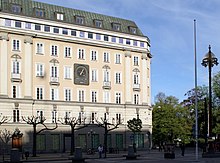
Back Robatori de Norrmalmstorg Catalan Røveriet på Norrmalmstorg Danish Geiselnahme am Norrmalmstorg German Ληστεία στο Νόρμαλμστοργκ Greek Robo de Norrmalmstorg Spanish Norrmalmstorgin pankkiryöstö Finnish שוד נורמלמסטורג HE Կողոպուտ Նորմալմսթորգ հրապարակում Armenian Bankaránið á Norrmalmstorgi Icelandic ノルマルム広場強盗事件 Japanese
| Norrmalmstorg robbery | |
|---|---|
 Front view of the former Kreditbanken building at Norrmalmstorg in 2005 | |
| Location | Norrmalmstorg, Stockholm, Sweden |
| Date | 23–28 August 1973 |
Attack type | Bank robbery, hostage taking |
| Weapons | Various |
| Injured | 2 |
| Perpetrators | Jan-Erik Olsson and Clark Olofsson |
The Norrmalmstorg robbery was a bank robbery and hostage crisis that occurred at the Norrmalmstorg Square in Stockholm, Sweden, in August 1973 and was the first crime in Sweden to be covered by live television. It is best known as the origin of the term Stockholm syndrome.[1]
Jan-Erik Olsson was a convicted criminal who had disappeared while on furlough from prison and then held up the Kreditbanken bank, taking four hostages in the process. During the negotiations that followed, Swedish Minister of Justice Lennart Geijer allowed Olsson's former cellmate and friend Clark Olofsson to be brought from prison to the bank. Although Olofsson was a long-time career criminal, it was deemed unlikely that he was in league with Olsson.[2] In the popular account, the hostages then bonded with their captors and refused to cooperate with police. However, it has also been argued that the hostages were simply distrustful of the police given the latter's willingness to risk the hostages' safety.[3] Police finally mounted a tear-gas attack five days into the crisis, and the robbers surrendered.
Olsson was sentenced to 10 years for the robbery, and Olofsson was ultimately acquitted. The counter-intuitive actions of the hostages led to a great deal of academic and public interest in the case, including a 2003 Swedish television film titled Norrmalmstorg, a 2018 Canadian film titled Stockholm and a 2022 Swedish Netflix television series Clark.[4]
- ^ Cite error: The named reference
40-ar-sedanwas invoked but never defined (see the help page). - ^ Svensson, Per (2016). Dramat på Norrmalmstorg: 23 till 28 augusti 1973. Albert Bonniers Förlag. ISBN 978-9100169350.
- ^ Hill, Jess (2019). See What You Made Me Do: Power, Control and Domestic Abuse. Melbourne: Black Inc. ISBN 978-1760641405. OCLC 1246246503.
- ^ "Swedish Crime-Drama Series 'Clark' on Netflix: Everything We Know So Far". Netflix. 14 December 2021.